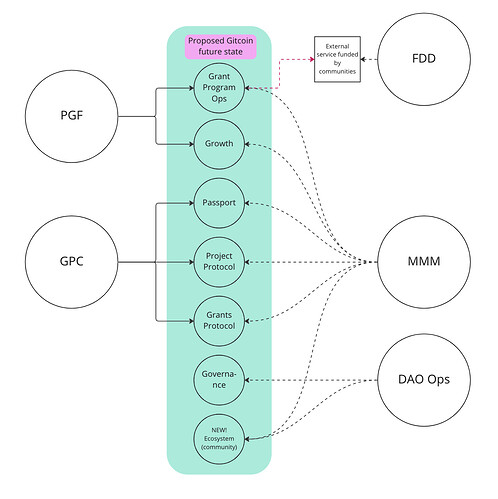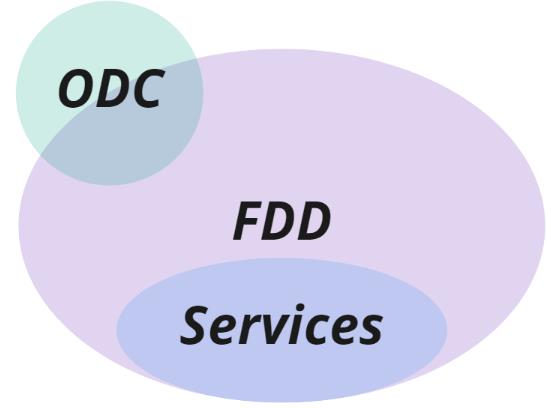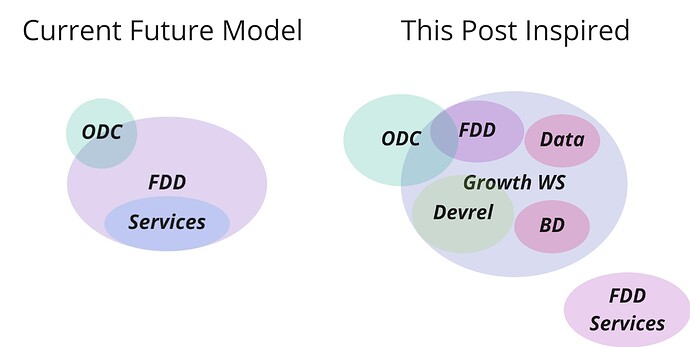Gitcoin’s next Iteration - Impact & Protocol DAO
This is my view on what the future might look like - I would encourage others to fork and write their version too!
It has been an immense amount of work for us to launch the DAO, and not one, two, but three distinct protocols over the last 18 months. During this time, we have seen change in how we organize, what initiatives we want to fund and plenty of disagreements on how we got here.
Now with the sweet smell of progress I am exploring what success might look like 3-5 years from now. Here is what I hope to see: Gitcoin will be the epicenter of funding in web3, and will continue to be a beacon of regenerative, public goods funding. Globally, grants programs will be easy to start and grow because of the Grants Suite, and those grants programs will be free of fraud, and abuse as there will be a plurality of anti sybil, identity and reputational systems in place to make attacking the grants programs prohibitively expensive. This means, communities everywhere will quickly and easily fund their shared needs with confidence in the outcomes they are committing funding to. We are starting to see novel mechanisms spring up around the protocols even today with hypercerts.xyz, mintkudos.xyz and others.
Over this same time horizon we will see new and novel analysis, interaction, and accountability models spring up built with the very grants data stored at the protocol layer. These new dApps (built by both Gitcoin, and other teams) will offer insights into the effectiveness of funding mechanisms, the validity of team’s ambitions (that receive funding) and we will better measure the true success of the capital that has been allocated.
When thinking about key performance indicators, or measurements of our success, I would expect us to continue to track total GMV (how much capital is flowing through the protocol to community’s shared needs. It would also make sense to track the average cost of forgery on each passport (or some unique humanity score), and to continue to ensure the protocols serve our web3 ecosystem, we should continue to track community engagement and decision making through decentralized means (this may be token voting, QV participation, etc.)
So how might we get there? I have been pondering what the next iteration of Gitcoin – the Protocol DAO – might look like if we are to achieve these ambitions. Will we still need the same workstream structure that are currently shaped like departments? Will we have the same metrics of success: GMV, and number of Grants rounds?
As I have been chatting with leaders in other DAOs, I am starting to form a strong opinion on the future shape that we may benefit from. I am forming this opinion based on beliefs for what our success might look like. Herein, I seek feedback to help shape the future, daylight my blindspots and generally help me improve my thinking.
Constituents we serve versus communities we want to cultivate
There have been some recent conversations within Gitcoin about the need to better define personas and the communities we want to cultivate. It is my belief that as a DAO we should focus on growing two communities - a community of developers who want to build on our protocols, and a community of regen maxis who want to help us fund public goods.
This means, donors who are funding public goods, ecosystems who want to run Grants rounds, project owners who want to apply for Grants rounds are not communities we want to cultivate. They are Gitcoin citizens and we want to serve them with our protocols, documentation, guides and resources. To put a finer point on this. I don’t think we should index on building communities of the constituents we serve. We should be focused on helping them solve their job to be done.
If we can clearly define which communities to cultivate, we can really focus our community efforts into a single workstream that recognizes both, who we want to serve via the protocols, documentation, guides, support channel, etc. and which communities we want to grow with engaging content, hackathons/bounties, token voting opportunities, etc.
This point could likely be its own post and perhaps I will come back to expand this thinking if it’s helpful. But it’s important for me to lay this out as it influences some of the material further down. Let’s talk more about how we might focus our energies to both serve our purpose and engage with each set of constituents.
Where are we: our Essential Intents
We have four Essential Intents today:
-
Protocol Adoption
a. Build a widely adopted, modular Grants protocol that creates a flourishing ecosystem of funding mechanisms.
b. [added later] Build a widely adopted, modular Pluralism Passport protocol that creates a flourishing ecosystem of network effects around Decentralized Society. -
Financial Sustainability
a. Have a comprehensive, diversified strategy for financial stability of the DAO in order to effectively achieve our mission. -
DAO Organization
a. Create and promote clear and engaging rituals, communication channels, and messaging that build emergent shared context among GitcoinDAO’s contributors, stewards, and supporters. -
Grants Program Success
a. Enable a successful grants protocol launch by dogfooding it internally and supporting ecosystems in adopting it.
b. Continue to support the Ethereum ecosystem and public goods in web3 and beyond through Gitcoin-led rounds.
These Essential Intents were written at a time when we did not have strong conviction that the Project Protocol (Grants Hub) should be a different protocol from the Grants Protocol (Round Manager). These were also written at a time when the “Grants Program” was everything we did Grants related - there was no delineation between a Grants Program and a Grants Services offering. These were written prior to us having any stables in our treasury, and prior to us having any real ideas on where protocol fees fit into what we are doing. GTC Utility was something we knew we wanted to focus on, but not ahead of nailing a few of our core competencies first (we are starting to nail them down now).
As for the protocol adoption Essential Intents, we are on track to make significant progress on these over the next 6 months with formal launches happening after EthDenver for the Grants protocol. Passport now has well over 100k Eth addresses signed up, and we continue to build integrations with teams who appreciate the stamps we are tracking. Developing a flourishing ecosystem is coming next with investments in DevRel and community development, like the Open Data Community.
Financial Sustainability is making progress, though it may not be quite as evident to most folks. I have strong conviction (thank you Scott for being the thought partner here) that the protocol should launch with a small fee model (2% of total proceeds flowing through the protocol) to support the DAO and our funding of public goods. GTC Utility details were shared in another post recently that folks can check out as well. Overall, we have stables in the treasury now and we have a protocol with a fee structure inbound.
DAO Organization is progressing, but at a snail pace given the entrenched nature of how people work. It is incredibly difficult to dramatically change how people work without also slowing down the velocity in which they work (initially). As a result, we have slowed the efforts to make big changes until “post Protocol Launch,” but I want to outline my thoughts for what this may look like below.
Grants Program Success is also on track. There are large strides being made by PGF to run multiple shadow rounds, test the protocols and to onboard grantees and round operators to the protocol. They are chomping at the bit to have a production ready protocol they can turn team members, and public goods funders on to. There are also other communities excited to run their own rounds.
So if these are on track (which I believe they are), when might the right time be to do a refresh? And if we were to refresh them, how might we do so in a way that encourages the outcomes we care about? I am going to venture a guess that the DAO wide outcome that we care about is that we (Gitcoin) can serve our purpose in perpetuity. The Essential Intents should define how we set ourselves up for that outcome.
Gitcoin’s next Essential Intents
Our next Essential Intents should continue to build on the success & focus we have had over the last 6mos, but also continue to narrow our focus on “the most important things.” More narrow because we are in a bear market, and more narrow as we are smarter on how best to fulfill our purpose into perpetuity. Here is high level thinking:
We should continue to focus on the growth and adoption of three distinct protocols: Grants Protocol, Project Protocol, Passport (names all TBD).
We should double down on our community efforts to grow and nurture the two communities we care about.
We should ensure the DAO continues to fund public goods (assuming it wants to), and we should have a small but nimble team focused on defining Gitcoin’s “shared needs” and ensuring they are funded (ie, how do we spend our $10MM matching pool funds).
We should accelerate other communities’ adoption of the protocols, and we should continue to build our excellence in understanding funding mechanisms that drive outcomes communities care about. This may happen for a small engagement fee (in addition to the protocol fee), but the fee is to promote self-reliance, not to line our coffers (ie, if there is a fee, a community may decide to run a round themselves instead of asking us to run the round for them).
Finally, we should ensure we have deep community involvement in how we build the protocols, how we allocate our matching pool funds, how we allocate the treasury (ie, Schelling point in or out?), and we should do more to work in public. Thinner workstreams, more bounties / project-based scopes of work and tighter feedback loops should be the norm IMO.
These core areas are not Essential Intents on their own. They are guiding thoughts for us as a DAO to discuss, and then define true Essential Intents in the near future.
Organization for the next era
This leads me to ponder, how might we make significant progress on these strategic areas? Are we organized in a way to be successful - should we make changes?
Here is my strawman for how we might narrow our focus to only the most critical of areas for the next 12 mos of this bear market.
Protocol focused workstreams (two in total: Grants stack, Passport) which include: Product Management, Eng, Design/Research, Product Marketing Management. The goal is to ensure they are building and shepherding the protocol’s growth in a way that the community agrees with and supports. Quarterly roadmap reviews can be done and commitments from the workstreams to accomplish XX functionality can be precursors to budgets being approved.
Gitcoin’s Grants program/workstream: a small team focused on running Gitcoin’s (token voted) categorical Grants Round. This team is exclusively focused on grants rounds for the Gitcoin DAO in the areas our community wants to spend funds. We believe consistency in funding is important for projects to flourish (ie, they need to know funds will be available in the future), finding ways to integrate the community’s sentiment regarding what to fund will be paramount.
Gitcoin Growth workstream: focuses on serving both our community & other communities’ growth - helping onboard and grow grants programs on the protocols. This team may have a small fee for running these services, but its focus is on protocol adoption and growth, not revenue. It likely needs to include marketing, round operators, BD/sales, and even some form of partner management. This workstream can start small (new or existing members) and grow as protocol adoption grows and we have more capital to allocate. Ideally external communities and teams find value in growing adoption of the protocol as well (as their shared needs will receive additional funding).
Community focused workstream: We can double down on the two communities we want to cultivate, and build out resources for the constituents we want to serve with functions like DevRel, Support, DAO/Community engagement, etc. Our community focused workstream would likely be heavily aligned with the protocol workstreams and the growth workstream to ensure there is connective tissue to the community from our workstreams.
Governance focused workstream where DAO wide frameworks can be developed and true Protocol related decision making can happen (ie, deployment and feedback mechanisms can be defined and implemented) – this may also include Ops too. Gitcoin will soon have three protocols and we have not yet built opportunities for the community to offer improvement proposals, roadmap advice, implementation decisions, etc. Ideally this group expands on the great work of our Steward reform to focus on how to ensure we are serving the community and not just our internal needs.
To be explicit (and this should not be treated as “the plan!” this is merely my opinion), this means FDD is spun out and funded by communities that want to enhance their Sybil defense (Gitcoin would likely be one of those “customers”). MMM is spread among different workstreams (protocols, community, PGF) and then also the DAO can decide on special projects to hire out for like our brand redesign, our website refreshes, etc. DAO Ops is mostly turned into the Governance focused workstream as the support team would be moved to Community. PGF is broken into two workstreams to really focus on running the DAO’s grants rounds quarterly (small and mighty team), and growing protocol adoption. GPC is broken into two workstreams with more community involvement in roadmapping and improvement proposals.
Budgeting… oh budgeting
It’s clear there is a lot of strife on the quarterly budgeting cycle today. Workstream leads are outlining what they want to accomplish for a season and Stewards continually have sticker shock on the cost to accomplish the outcomes defined. I am of the opinion we need to do budgeting more frequently with a smaller cost of getting it wrong, or a budget proposal being voted down. As noted in other areas, there is very rarely dissection in our voting and it’s likely because we are not being ambitious enough in the proposals we seek, but also we are not offering options where people feel they can say no.
With seven workstreams, each equipped with the cross functional skill set to be successful, we will have more granular control over what outcomes are proposed and also what scope we can take on. A goal I would have with budgeting revisions is that it is more fluid to enable community bounties and projects to be evaluated with equal weighting as a workstreams budget. Other DAOs do this frequently (Nouns, Synthetix, etc.) and I think we are at the right time to move away from the heavy, quarterly bounded voting schema to a more fluid, outcome based approach.
There has already been great work by others outlining a thesis for how we might budget, but I fear it tries to “delay the pain” by spreading out the budgeting process over a longer duration of time, instead of tackling the core issues up front (the scopes are too large, there is little accountability because the scope is so large, etc.). I am reminded of how painful software deployment used to be - the solution has been to introduce continuous delivery/deployment… not further the waterfall method of only shipping annually.
Summing it up
I believe that realigning the DAO to be focused on Protocol growth, whilst not losing our soul of Public Goods funding will be imperative for our (close to?) final form. When someone asks “What is Gitcoin?” It should be clear - (assuming the DAO agrees) We are an impact & protocol DAO that funds public goods and enables others to fund their shared needs too.
These changes will give each workstream the ability to own its success and the community the ability to hold workstreams accountable to outcomes they define as they will be smaller and without as many dependencies. If stewards are unhappy with the cost of accomplishing something, they can ask for a reduction in cost to achieve that outcome. If that is not feasible (ie, the people working on accomplishing that outcome cannot reduce cost beyond their proposal), the community can decide to fork that effort and try to do it themselves in a different workstream/proposal.
Thanks for reading the wall of text, and let’s see if we can break this down to affect some of these changes over the next 6mos.


